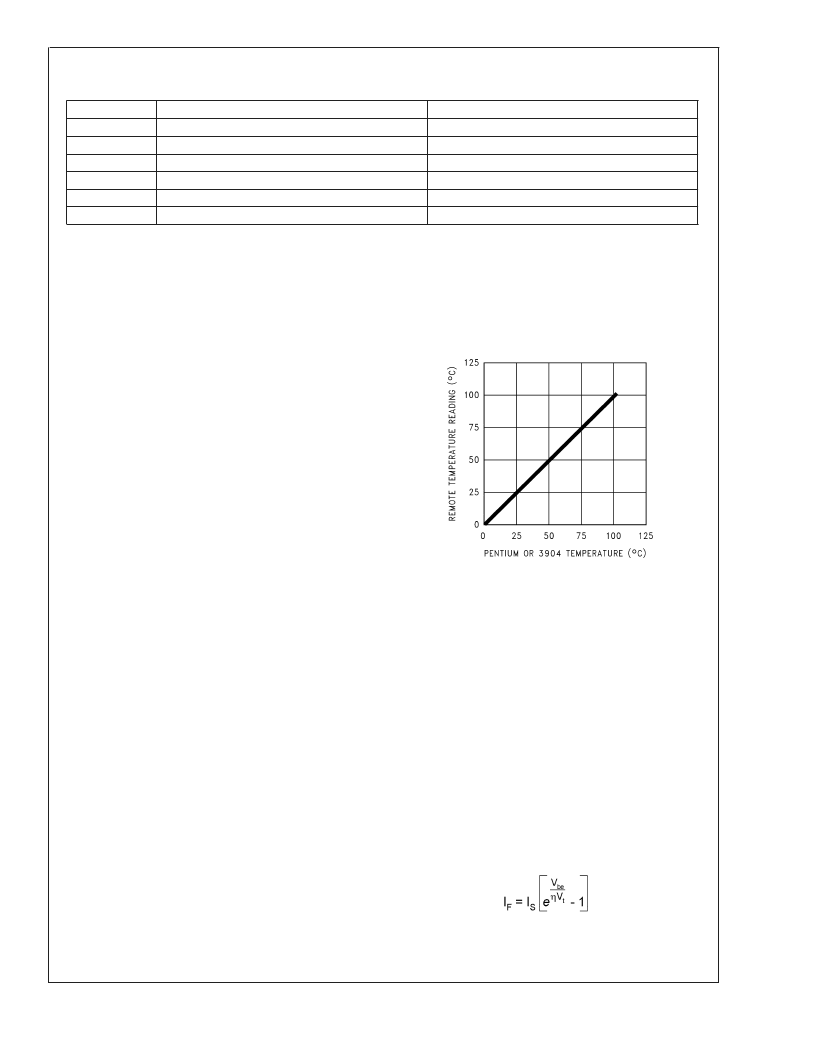- 您現(xiàn)在的位置:買賣IC網(wǎng) > PDF目錄358841 > LM32 (National Semiconductor Corporation) Dual Thermal Diode Temperature Sensor with SensorPath Bus PDF資料下載
參數(shù)資料
| 型號: | LM32 |
| 廠商: | National Semiconductor Corporation |
| 元件分類: | 溫度/濕度傳感器 |
| 英文描述: | Dual Thermal Diode Temperature Sensor with SensorPath Bus |
| 中文描述: | 雙熱二極管溫度傳感器SensorPath總線 |
| 文件頁數(shù): | 21/24頁 |
| 文件大?。?/td> | 340K |
| 代理商: | LM32 |

2.0 Register Set
(Continued)
Conversion Rate Control
(Continued)
[CR1:CR0]
01
01
10
10
11
11
LowPwr
0
1
0
1
0
1
Typical Conversion Rate (ms)
91
364
182 (default)
728
364
1456
*Fastest: 2x7.5ms(remote) + 7.5msec (local) = 22.5 ms total
The sensor conversion rate is controlled by this register as well as the Low Power Bit of Device Control Register. This register is
not defined by the SensorPath specification. Therefore, on a motherboard when using a Super I/O host this register must be
modified during BIOS run time. The conversion rate is dependent on system physical requirements and limitations. The thermal
response time of the MSOP package is one such requirement. Most systems will function properly with the default settings. The
master scan rate is related to the conversion rate of the LM32. If attentions are enabled the conversion rate and scan rate will be
equal.
3.0 Application Hints
The LM32 can be applied easily in the same way as other
integrated-circuit temperature sensors, and its remote diode
sensing capability allows it to be used in new ways as well.
It can be soldered to a printed circuit board, and because the
path of best thermal conductivity is between the die and the
pins, its temperature will effectively be that of the printed
circuit board lands and traces soldered to the LM32’s pins.
This presumes that the ambient air temperature is almost the
same as the surface temperature of the printed circuit board;
if the air temperature is much higher or lower than the
surface temperature, the actual temperature of the of the
LM32 die will be at an intermediate temperature between the
surface and air temperatures. Again, the primary thermal
conduction path is through the leads, so the circuit board
temperature will contribute to the die temperature much
more strongly than will the air temperature.
To measure temperature external to the LM32’s die, use a
remote diode. This diode can be located on the die of a
target IC, allowing measurement of the IC’s temperature,
independent of the LM32’s temperature. The LM32 has been
optimized to measure the remote diode of a 90 nm Pentium
4 processor as shown in
Figure 7
. A discrete diode can also
be used to sense the temperature of external objects or
ambient air. Remember that a discrete diode’s temperature
will be affected, and often dominated, by the temperature of
its leads.
Most silicon diodes do not lend themselves well to this
application. It is recommended that a 2N3904 transistor
base emitter junction be used with the collector tied to the
base.
A diode connected 2N3904 approximates the junction avail-
able on a Pentium microprocessor for temperature measure-
ment. Therefore, the LM32 can sense the temperature of this
diode effectively. Although, an offset will be observed. The
temperature reading will be offset by approximately 4.5C,
therefore a correction factor of +4.5C should be added to all
temperature readings when using a 2N3904 transistor.
3.1 DIODE NON-IDEALITY
3.1.1 Diode Non-Ideality Factor Effect on Accuracy
When a transistor is connected as a diode, the following
relationship holds for variables V
BE
, T and I
f
:
where:
20071115
FIGURE 7. 90 nm Pentium 4 Temperature vs LM32
Temperature Reading
L
www.national.com
21
相關(guān)PDF資料 |
PDF描述 |
|---|---|
| LM3302J | QUADRUPLE DIFFERENTIAL COMPARATOR |
| LM3302M96 | Quad Voltage Comparators for Industrial, Commercial and Military Applications |
| LM3302N | Quad Voltage Comparators for Industrial, Commercial and Military Applications |
| LM3302 | Quad Voltage Comparators for Industrial, Commercial and Military Applications |
| LM3311 | Step-Up PWM DC/DC Converter with Integrated LDO, Op-Amp, and Gate Pulse Modulation Switch |
相關(guān)代理商/技術(shù)參數(shù) |
參數(shù)描述 |
|---|---|
| LM320 | 制造商:NSC 制造商全稱:National Semiconductor 功能描述:Series 3-Terminal Negative Regulators |
| LM3200 | 制造商:WABER 功能描述: |
| LM3200_05 | 制造商:NSC 制造商全稱:National Semiconductor 功能描述:Miniature, Adjustable, Step-Down DC-DC Converter with Bypass Mode for RF Power Amplifiers |
| LM320081 | 制造商:Sharp Microelectronics 功能描述:4.7 DFSTN REFLECTIVE 3 |
| LM3200TL | 制造商:Rochester Electronics LLC 功能描述: 制造商:Texas Instruments 功能描述:IC BUCK CONVERTER POWERWISE 3200 |
發(fā)布緊急采購,3分鐘左右您將得到回復(fù)。